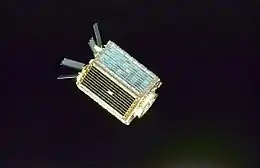 MightySat-1 photograph | |
| Mission type | Technology |
|---|---|
| Operator | AFRL |
| COSPAR ID | 1998-069C |
| SATCAT no. | 25551[1] |
| Spacecraft properties | |
| Manufacturer | Spectrum Astro |
| Launch mass | 320 kilograms (710 lb)[2] |
| Dry mass | 63.5 kilograms (140 lb) |
| Start of mission | |
| Launch date | December 4, 1998 |
| Rocket | Space Shuttle Endeavour (STS-88) |
| Launch site | Kennedy LC-39A |
| End of mission | |
| Decay date | November 21, 1999, 17:11 UTC |
| Orbital parameters | |
| Reference system | Geocentric |
| Regime | Low Earth |
| Eccentricity | 0.00095976377 |
| Perigee altitude | 388.0 kilometers (241.1 mi) |
| Apogee altitude | 401.0 kilometers (249.2 mi) |
| Inclination | 51.6& degrees |
| Period | 92.4 minutes |
| Epoch | January 4, 1999[1] |
MightySat-1 was a small spacecraft developed by the U.S. Air Force's Phillips Laboratory (now part of the Air Force Research Laboratory Space Vehicles Directorate) to test technology for small satellites, including advanced dual-junction solar cells, a composite structure, a micrometeorite and debris detector, low-power electronics and a low-shock release device.[2] The 140-pound satellite was launched from the Space Shuttle Endeavour in December 1998, during the 12th day of the STS-88 mission[2] and performed robustly in orbit, with no spacecraft anomalies during its mission. Lt. Barbara Braun of the AFRL was the program manager for the satellite.[2]
MightySat-1's mission ended when it re-entered the atmosphere at 17:11 UTC on November 21, 1999.[3]
References
- 1 2 McDowell, Jonathan. "Master Satellite List". Jonathan's Space Report. Retrieved 26 February 2014.
- 1 2 3 4 "MightySat 1". Astronautix. Archived from the original on July 2, 2002. Retrieved 26 February 2014.
- ↑ "MightySat-1". GlobalSecurity.org. Retrieved 2008-07-29.